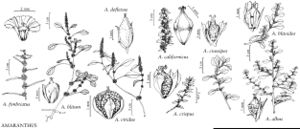Difference between revisions of "Amaranthus deflexus"
Mant. Pl. 2: 295. 1771.
FNA>Volume Importer |
imported>Volume Importer |
||
| (3 intermediate revisions by 2 users not shown) | |||
| Line 8: | Line 8: | ||
}} | }} | ||
|common_names=Large-fruit amaranth;Argentina amaranth;deflexed amaranth;low amaranth | |common_names=Large-fruit amaranth;Argentina amaranth;deflexed amaranth;low amaranth | ||
| + | |special_status={{Treatment/ID/Special_status | ||
| + | |code=I | ||
| + | |label=Introduced | ||
| + | }}{{Treatment/ID/Special_status | ||
| + | |code=F | ||
| + | |label=Illustrated | ||
| + | }} | ||
|basionyms= | |basionyms= | ||
|synonyms= | |synonyms= | ||
| Line 24: | Line 31: | ||
|elevation=0-500 m | |elevation=0-500 m | ||
|distribution=Ala.;Calif.;Fla.;Ga.;La.;Mass.;N.J.;N.Y.;Oreg.;Pa.;Tenn.;Va.;native to South America;locally introduced or naturalized in tropical to warm-temperate regions of the globe. | |distribution=Ala.;Calif.;Fla.;Ga.;La.;Mass.;N.J.;N.Y.;Oreg.;Pa.;Tenn.;Va.;native to South America;locally introduced or naturalized in tropical to warm-temperate regions of the globe. | ||
| + | |introduced=true | ||
|discussion=<p>The hybrid between <i>Amaranthus deflexus</i> and <i>A. muricatus</i> was described from Europe as A. ×tarraconensis Sennen & Pau (see J. L. Carretero 1979) and may be expected in North America in the future in places of possible co-occurrence of the parental species.</p> | |discussion=<p>The hybrid between <i>Amaranthus deflexus</i> and <i>A. muricatus</i> was described from Europe as A. ×tarraconensis Sennen & Pau (see J. L. Carretero 1979) and may be expected in North America in the future in places of possible co-occurrence of the parental species.</p> | ||
|tables= | |tables= | ||
| Line 33: | Line 41: | ||
-->{{#Taxon: | -->{{#Taxon: | ||
name=Amaranthus deflexus | name=Amaranthus deflexus | ||
| − | |||
|authority=Linnaeus | |authority=Linnaeus | ||
|rank=species | |rank=species | ||
| Line 48: | Line 55: | ||
|publication title=Mant. Pl. | |publication title=Mant. Pl. | ||
|publication year=1771 | |publication year=1771 | ||
| − | |special status= | + | |special status=Introduced;Illustrated |
| − | |source xml=https:// | + | |source xml=https://bitbucket.org/aafc-mbb/fna-data-curation/src/2e0870ddd59836b60bcf96646a41e87ea5a5943a/coarse_grained_fna_xml/V4/V4_841.xml |
|genus=Amaranthus | |genus=Amaranthus | ||
|subgenus=Amaranthus subg. Albersia | |subgenus=Amaranthus subg. Albersia | ||
Latest revision as of 22:01, 5 November 2020
Plants short-lived perennial or annual, pubescent in distal parts of plant or becoming glabrescent at maturity. Stems ascending or prostrate, profusely branched basally, radiating from rootstock, mostly 0.2–0.5 m. Leaves: petiole 1/2 as long as to equaling blade; blade rhombic-ovate or ovate to lanceolate, 1–2 × 0.5–1 cm, base tapering or cuneate, margins entire, plane or slightly undulate, apex subacute, obtuse, or retuse or shallowly emarginate, mucronulate. Inflorescences terminal, erect, compact, pyramidal panicles and also some axillary clusters, green or silvery green, occasionally tinged with red, leafless at least distally. Bracts of pistillate flowers linear, 0.5–1 mm, 1/2 as long as tepals. Pistillate flowers: tepals 2–3, narrowly elliptic or oblanceolate, not clawed, equal or subequal, 1.2–2 mm, apex broadly acute; style branches erect; stigmas 3. Staminate flowers clustered at tips of inflorescences; tepals 2–3; stamens 2–3. Utricles marked with 2(–3) green lines that intersect at apex and divide fruit into halves or quarters, slightly to distinctly inflated, ellipsoid, 2–3 mm, distinctly longer than tepals, smooth (in dry plants wrinkled or rugose), indehiscent. Seeds very dark brown to black, 1–1.2 mm diam., shiny, filling only proximal portion of fruit.
Phenology: Flowering summer–fall.
Habitat: Weedy areas, ballast heaps, railroads, other disturbed habitats
Elevation: 0-500 m
Distribution
Introduced; Ala., Calif., Fla., Ga., La., Mass., N.J., N.Y., Oreg., Pa., Tenn., Va., native to South America, locally introduced or naturalized in tropical to warm-temperate regions of the globe.
Discussion
The hybrid between Amaranthus deflexus and A. muricatus was described from Europe as A. ×tarraconensis Sennen & Pau (see J. L. Carretero 1979) and may be expected in North America in the future in places of possible co-occurrence of the parental species.
Selected References
None.
